ISTANBUL
Istanbul is the only city in the world located on two continents - Europe and Asia. During its 25,000-year history, it has been the capital of the Roman, Byzantine, and Ottoman Empires. With her gorgeous heritage, Istanbul offers various places and monuments to see. Many of the top sights such as Topkapi Palace, Hagia Sophia (Aya Sofya), the Blue Mosque (Sultanahmet Camii) and the Hippodrome, are in Sultanahmet (old Istanbul area), as are many good istanbul hotels.Old Istanbul area is also one of the two sites of Turkey with Cappadocia, which first listed in UNESCO World Heritage List.
Hagia Sophia (Aya Sofya)
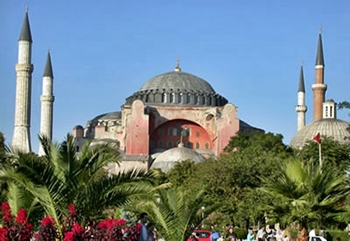 The Basilica of Hagia Sophia was constructed by Roman Emperor Justinian in 537 AD. This was the largest church in the Christian world for a thousand years.Its immense dome rises nearly 200 feet above the ground and its diameter spans more than 100 feet. The mosaics covering the walls are among the most important works of art that have survived to this day of the Byzantine era.
The Basilica of Hagia Sophia was constructed by Roman Emperor Justinian in 537 AD. This was the largest church in the Christian world for a thousand years.Its immense dome rises nearly 200 feet above the ground and its diameter spans more than 100 feet. The mosaics covering the walls are among the most important works of art that have survived to this day of the Byzantine era. Large round buildings had been successfully covered by domes before, but Hagia Sophia had a rectangular floor plan, and covering a large rectangular structure by a huge central dome was being tried for the first time in history. The dome collapsed and repaired many times.
The Ottomans converted the basilica to a mosque in the 15 th century after the conquest of Istanbul. Recognizing its historic and universal importance, the Turkish Government turned it into a museum in 1935.
The Blue Mosque (Sultanahmet Camii)
Sultanahmet Mosque is the most famous monument in both the Turkish and the Islamic worlds. It was built in the classic Turkish
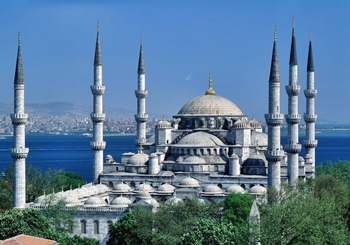 architectural style between 1609-1616 by the architect Mehmet. The building is more familiarly known as the Blue Mosque because of its magnificent interior paneling of more than 20,000 blue and white Iznik tiles.
architectural style between 1609-1616 by the architect Mehmet. The building is more familiarly known as the Blue Mosque because of its magnificent interior paneling of more than 20,000 blue and white Iznik tiles. The inside is a single immense space into which the light pours from 260 windows. The dome 141 feet high, is supported by four enormous circular pillars 16 feet in diameter and are known as elephant feet. As it is located across Hagia Sophia, the mosque was designed to be as large and as magnificent as this Byzantine structure.
Topkapi Palace
Topkapi Palace is certainly the most important historical site to be visited in Istanbul. It is one of the most frequently visited museums of Europe and is the most visited one in Turkey. The Palace served as the administrative center of the Ottoman Empire for nearly 400 years between the 15th and 19th centuries. Its principal parts were finished in 1478, then altered and enlarged by new additions in the reign of each succeeding sultan. The Palace was abandoned in 1855 when Sultan Abdulmecit I, 31st Sultan of the Ottoman Empire, moved to the new Palace of Dolmabahce. In 1924, it was turned into a museum upon the orders of Ataturk.
 Palace is a complex of buildings spread out over one of the seven hills of Istanbul. It consists of courtyards serving different purposes which are separated from each other by monumental gates. Pavilions, each used for different purpose, surround these courtyards. The total area of the Palace is twice the area of Vatican and half of Monaco in size.
Palace is a complex of buildings spread out over one of the seven hills of Istanbul. It consists of courtyards serving different purposes which are separated from each other by monumental gates. Pavilions, each used for different purpose, surround these courtyards. The total area of the Palace is twice the area of Vatican and half of Monaco in size.Besides being the official residence of the Sultan, the Topkapi Palace served as the headquarters of the government. It also housed the state treasury and the archives. The mint, as well as the highest educational institution were located on the Palace grounds.
On exhibitions are the imperial collections of crystal, silver and Chinese porcelain; imperial handmade costumes worn by the sultans and their families, the famous jewels of the treasury; the richest collection of clocks in the world; the sacred relics of Islam including the swords of Muhammed, his bow and his mantle; priceless collection of miniatures and many other priceless objects. One of the largest diamonds in the world, the Spoonseller Diamond, is displayed in a special showcase in the hall. The rooms are exquisitely decorated and tiled.
Dolmabahce Palace
Dolmabahce Palace, built in the mid-19th century by Sultan Abdülmecit 1, stretches for 600 meters along the European shore of the Bosphorus. The palace has survived intact with its original decorations, furniture, silk carpets, curtains and everything else. It is said that 14 tons of gold and 40 tons of silver were used for the decoration of the palace.
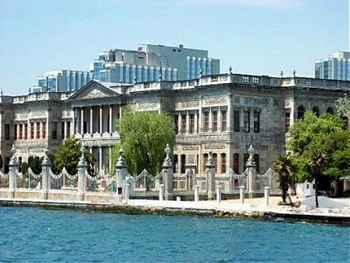 Dolmabahce palace contains 285 rooms, 43 salons and six baths. Its walls and ceilings are covered with paintings by the famous artists of that age. Rare handmade art objects from Europe and the Far East decorate every room in the palace. The ballroom is the largest of its kind in the world. A 4.5 ton giant-sized crystal chandelier with 750 bulbs hangs from the 120 feet high dome. The floors are parquet, of exceptional quality and are laid with high-quality silk carpets, hand-woven in the Imperial Factory of Hereke.
Dolmabahce palace contains 285 rooms, 43 salons and six baths. Its walls and ceilings are covered with paintings by the famous artists of that age. Rare handmade art objects from Europe and the Far East decorate every room in the palace. The ballroom is the largest of its kind in the world. A 4.5 ton giant-sized crystal chandelier with 750 bulbs hangs from the 120 feet high dome. The floors are parquet, of exceptional quality and are laid with high-quality silk carpets, hand-woven in the Imperial Factory of Hereke. Ataturk used to stay in this palace when he visited Istanbul. He died here in 1938. All the clocks in the palace were stopped at 9:05 am, the time of his death, in memory of this great Türk.
The Palace which is a museum today is open on certain days of the week, and it is one of those historic places in Istanbul that must be visited.
Kariye Museum ( The Chora Church )
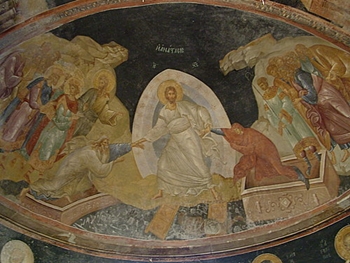 The Kariye Museum is, after Hagia Sophia, the most important Byzantine monument in Istanbul. The existing building was built towards the end of the 11th century and dedicated to Christ the Savior. After the Turkish conquest, the church remained deserted for a time, and was turned into a mosque in 1511 by addition of a minaret. It became a museum in 1948 and its frescoes were cleaned and restored by the American Institute of Byzantine Research.
The Kariye Museum is, after Hagia Sophia, the most important Byzantine monument in Istanbul. The existing building was built towards the end of the 11th century and dedicated to Christ the Savior. After the Turkish conquest, the church remained deserted for a time, and was turned into a mosque in 1511 by addition of a minaret. It became a museum in 1948 and its frescoes were cleaned and restored by the American Institute of Byzantine Research. The walls are decorated with superb 14th century mosaics, illustrating scenes from the life of Christ and the Virgin Mary. These are the finest masterpieces of Christian religious art to be found anywhere in the world. Paintings, rocks and architectural designs seen in the background make the pictures three-dimensional. The scenes are made with special care for them to look daily, lively and ordinary. The scenes are enriched with explicating stories near them.
Yerebatan Sarnici (The Underground Cistern)
The Underground Cistern is one of the most extraordinary and impressive buildings in Istanbul. The structure was known in Byzantium as "Basilica Cistern" because it lays beneath the Stoa Basilica, the great public square on the First Hill.
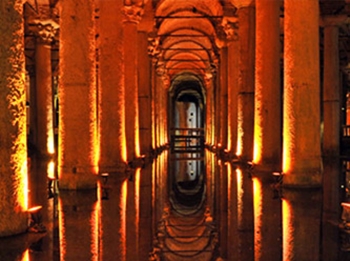 The Basilica Cistern was built by Justinian I after the bloody Nika Revolt in 532, probably as an enlargement of an earlier cistern which was constructed by Constantine the Great. During the Byzantium Period, it was used as a reservoir for water storage for the Great Palace and other buildings in the First Hill. During the Ottoman Period, the water was used for Topkapi Palace and watering the gardens of it. However the cistern had its brighest days during the Byzantium Period.
The Basilica Cistern was built by Justinian I after the bloody Nika Revolt in 532, probably as an enlargement of an earlier cistern which was constructed by Constantine the Great. During the Byzantium Period, it was used as a reservoir for water storage for the Great Palace and other buildings in the First Hill. During the Ottoman Period, the water was used for Topkapi Palace and watering the gardens of it. However the cistern had its brighest days during the Byzantium Period. The interior of Underground Cistern is breathtaking. It is 138 m, 452 ft long by 65m, 213 ft wide. There are 336 columns in the cistern. Most of the column capitals are either in Corinthian or Doric Style. At the far end of the Cistern, there are two heads of Medusa which are put upside down or side ways. The Medusa Heads are taken from an ancient Pagan site but they complement the pillars very beautifully and add a different taste to the building.
The Bosporus
 The Bosporus or Bosphorus, also known as the Istanbul Strait, (Turkish: Bogaz or Bogazici) is a strait that forms the boundary between the European part (Rumelia) of Turkey and its Asian part (Anatolia). Its English name comes from a Greek legend: Zeus had an affair with a beautiful women named Io. When Hera, his wife, discovered his infidelity, she turned Io into a cow and created a horsefly to sting her on the rump. Io jumped clear across the strait. Thus bous=cow, and poros=crossing-place:
The Bosporus or Bosphorus, also known as the Istanbul Strait, (Turkish: Bogaz or Bogazici) is a strait that forms the boundary between the European part (Rumelia) of Turkey and its Asian part (Anatolia). Its English name comes from a Greek legend: Zeus had an affair with a beautiful women named Io. When Hera, his wife, discovered his infidelity, she turned Io into a cow and created a horsefly to sting her on the rump. Io jumped clear across the strait. Thus bous=cow, and poros=crossing-place: Bosporus= "crossing-place of the cow."
Bosporus is the world's narrowest strait used for international navigation. It connects the Black Sea with the Sea of Marmara, which is connected by the Dardanelles to the Aegean Sea, and thereby to the Mediterranean Sea. It is approximately 30 km long, with a width of changing between 700 and 3700 meters. The depth varies from 36 to 124 metres in midstream.
The shores of the strait are heavily populated as the city of Istanbul with a metropolitan area in excess of 12 million inhabitants straddles it.
Two bridges cross the Bosporus named the Bosphorus Bridge and Fatih Sultan Mehmet (Bosphorus II) bridge.
The Hippodrome
The vast area covered by the Hippodrome lies between Hagia Sophia and the Blue Mosque. It is also known as At Meydani, or plaza of the horses, as after the conquest of Cinstantinople it was used principally for horse races.
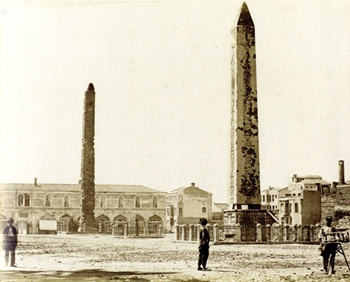 The Hippodrome was built in 203 A.D. under Septimius Severus. It was enlarged and embellished by Constantine in 325 and recalls the Circus Maximus in Rome. 100,000 spectators could gather there in forty rows of seats. The athletes were divided into four factions: the Blues, the Greens, the Reds, and the Whites. The emperor's box, decorated with four splendid bronze horses which are now in Venice, was to the north. The Hippodrome was resplendent with statues, obelisks and trophies, which came from various countries.
The Hippodrome was built in 203 A.D. under Septimius Severus. It was enlarged and embellished by Constantine in 325 and recalls the Circus Maximus in Rome. 100,000 spectators could gather there in forty rows of seats. The athletes were divided into four factions: the Blues, the Greens, the Reds, and the Whites. The emperor's box, decorated with four splendid bronze horses which are now in Venice, was to the north. The Hippodrome was resplendent with statues, obelisks and trophies, which came from various countries. Now only three monuments left: the obelisk of Theodosius, the Serpentine Column and obelisk of Constantine, better known as the walled obelisk.
The Grand Bazaar (Kapali Carsi)
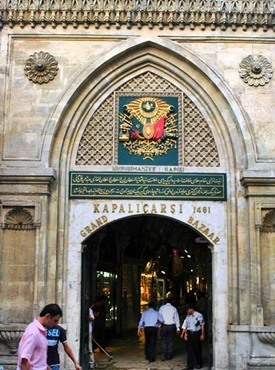 The grand covered bazaar of Istanbul, the Kapali Carsi is not simply a complex of buildings, but a real city covered by hemispheric domes with its streets, small squares surrounded by porticoes, entrances (eighteen in all), five mosques and six fountains. The 200,000 square meters area make Grand Bazaar one of the largest souks in the world. In Byzantine times venders already set up their stalls here. Then in 1461 Mehmet II, the Conqueror built the first covered bazaar in the world which was burnt by the fire more than once until it was finally rebuilt in stone.
The grand covered bazaar of Istanbul, the Kapali Carsi is not simply a complex of buildings, but a real city covered by hemispheric domes with its streets, small squares surrounded by porticoes, entrances (eighteen in all), five mosques and six fountains. The 200,000 square meters area make Grand Bazaar one of the largest souks in the world. In Byzantine times venders already set up their stalls here. Then in 1461 Mehmet II, the Conqueror built the first covered bazaar in the world which was burnt by the fire more than once until it was finally rebuilt in stone.It is a never-ending succession of brightly-colored noisy shops, full of light and life. Typical Turkish souvenirs can be bought here like jewelry, leather jackets, brassware, coffee cups and soft carpets.
Please visit our Istanbul Tours page or
send us an email (info@goreme.com) for further information.
